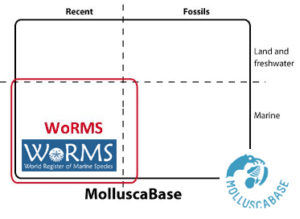Links
For starters and the youngest amongst us:
All about Malacology: English website with links to cool vidoes and websites. Ideal for starters of all ages.
Phylum Mollusca: A few basics about Mollusca.
Crate & basket: English blog with cool information and interesting info on feeding habits of some garden snails and some sea snails.
BIBLIOGRAPHY – links The three most important and most enriched databases for molluscan litterature are without doubt Biodiversity Heritage Library, AnimalBase and Gallica. Their links can be found underneath.:
The three most important and most enriched databases for molluscan litterature are without doubt Biodiversity Heritage Library, AnimalBase and Gallica. Their links can be found underneath.:
Biodiversity Heritage Library
Animalbase
Gallica (Bibliothèque nationale de France)
Other literature-links:
e-rara – Swiss website containing quite a few works on Zoology – some hard to find.
JSTOR – American website linked to Ithaca. After creation of a login quite a lot is available without cost..
Forgottenbooks – with a few classics within the sections Biology and Paleontology
Bayerische Staatsbibliothek – contains some hard-to-find works, mostly Paleontology (e. g. Giebel; 1866).
Attention!: Most literature dating from after 1925 still is copyright protected.. Some magazines (e. g. The Nautilus) did provide permission to BHL to upload all volumes to date, yet most magazines haven’t done so.
TAXONOMY – links
 THE two on-line databases containing names of marine organisms (WoRMS) and recent and fossil terrestrial, freshwater and marine Mollusca can’t be ignored here. Their links:
THE two on-line databases containing names of marine organisms (WoRMS) and recent and fossil terrestrial, freshwater and marine Mollusca can’t be ignored here. Their links:
WoRMS (World Register of Marine Species)
Molluscabase
For members: Further information on these databases can be found here. (Monthly meeting February, 2020)
Did you know?: The Molluscabase logo was designed by our Dutch shell-colleague Jan-Johan Ter Poorten.
MUSEUMS – collecties links – deel 1
Did you know?: That a large number of British museums composed a large on-line database together.
This database can be accessed via Mollusca Types in Great Britain,
Via the page Tracing Collections of that website, one can download the valuable Excel file by S. Peter Dance , containing more than 500 authors and where their reference material can be found..
MUSEUMS – collections links – part 2 Also the collection of Linnaeus himself can be found on-line via: http://linnean-online.org/shells.html.
Also the collection of Linnaeus himself can be found on-line via: http://linnean-online.org/shells.html.
The specimens, seen by Linnaeus from the collection of Queen Ludovica Ulrica (before he wrote the 10th edition, yet only published in in 1764) can be consulted via the website of the Uppsala University, Museum of Evolution, Zoology section. Attention!: The website mentions that not all specimens have been digitized as yet.
Treating Linnaean taxa is more than Linnaeus’ collection alone. It is advised to consult a specialist on that matter.
MUSEUMS – collections – part 3 – WITHIN Europe (excluding British museums – also see part 1 above).
Muséum national d’Histoire naturelle, Parijs
Natuurhistorisch Museum, Rotterdam
This site contains photographs of the samples in their collection, and is ideal as a visual aid for identification. The database as such (without photographs) is situated within the GBIF platform.
Senckenberg (SMF, Frankfurt, SNSD, Dresden, SMNG, Görlitz and the paleontological collection at Marburg)
Senckenberg is currently in the middle of a conversion of databases. The older, less easy though richer in data is called SeSam, en the new, more intuitive one is called AQUILA. Both contain fossil records as well as recent ones per consulted taxon, though in SeSam one has to query one museum at a time, and in AQUILA, all museums can be searched in a single query.
The Museum für Naturkunde (Berlin) and the Löbbecke Museum und Aquazoo (Düsseldorf) have their material available on-line via SysTax.
MUSEUMS – collections – part 4 – OUTSIDE Europe
Academy of Natural Sciences of Drexel University, Philadelphia
Attention! (recent) “Malacology” and “invertebrate paleontology” are 2 separate databases. One can see both links in the list on the left hand side once the site is opened.
Field Museum of Natural History, Chicago, Illinois (USA)
Museum of Comparative Zoology – Harvard University
Smithsonian Museums, Washington, D. C. (National Museum of Natural History)
GENERAL links to Publications – History – Events
The “natural history” of Stromboidea can be found via the website of Uli Wieneke and his team: Stromboidea.de
Hardy’s Internet Guide to Marine Gastropods (& Near Classes) also contains a large number of photographs for visual identification.
A lot of photographs for identification can be found on the website of the Rotterdam Natural History Museum.
Conchology, Inc contains a treasure of information regarding Events, Publications and Historical figures from the malacological world..
Info about famous people from the malacological history can be found on the website of the American Malacological Society (2400 Years of Malacology)
Via the website of the Smithsonian Libraries, you can access a searchable, digital version of the famous Index Animalium by Sherborn & Sykes.
Other interesting links to clubs and associations:
Belgian society for conchology – department Coast
Société Royale Belge de Malacologie
The Malacological Society of Australasia
Deutsche Malakozoologische Gesellschaft
Association Française de Conchyliologie
The Malacological Society of London
Unitas Malacologica
Società Italiana di Malacologia
Nederlandse Malacologische Vereniging
Conchologists of America

